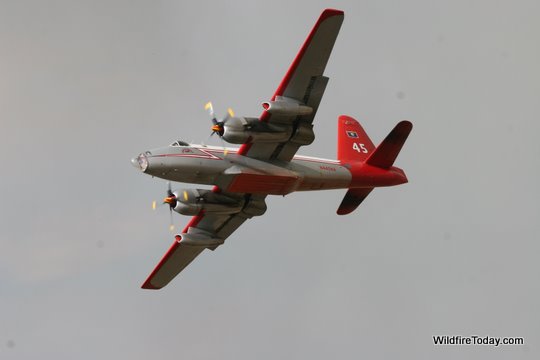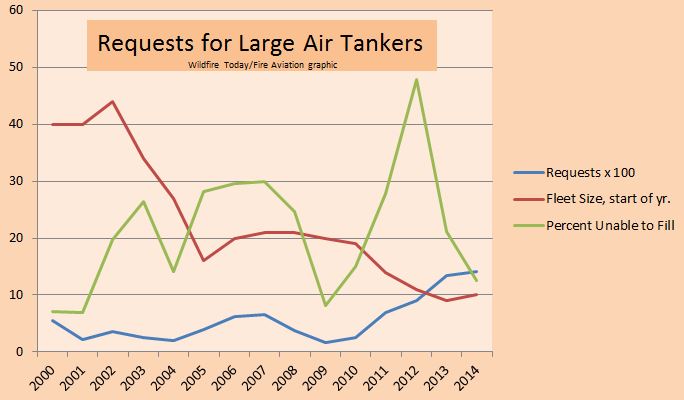
We just became aware of another air tanker study that the U.S. Forest Service commissioned. By our count this is the 13th federal study on the use of air tankers since 1995, and was one of three completed in 2013. (A list of the studies is at Wildfire Today.)
Titled Large airtanker use and outcomes in suppressing wildland fires in the United States, it was written in 2013 and published in the International Journal of Wildland Fire in February, 2014. The document maintained a low profile, possibly because it was behind the journal’s pay wall, rather than being an Open Access document.
The study attempts to determine how effective large air tankers (LAT) have been at preventing fires from escaping initial attack (IA). The authors begin by describing the poor data that they used to develop their conclusions. For example, the sparse data made it very difficult “to track drop location and time, to associate drops to specific fire events, to gather information on the fire environment (fuels, weather, terrain, etc.) at the time of the drop and, critically, to clearly identify mission objectives for each drop.”
The authors used some convoluted methods to make guesses about which retardant drops were on IA fires and which ones were not. And, “due to data availability issues” they only considered stats from two years, 2010 and 2011. In 2010 there were 19 LATs in the fleet at the beginning of the year and 14 in 2011, but by the end of 2011 the study reports there were only 10 available.
Since the air tanker fleet has atrophied from 44 in 2002 to as low as 9 in 2013, it has been impossible to always produce a LAT every time one is needed on IA. And if it does show up, the chances of it arriving while there is still a chance to slow the spread, enabling ground based firefighters to contain the fire, are not as great as they were in 2002 when there were almost five times as many air tankers.
The authors addressed the timing of air tanker drops:
Therefore, the determination of whether or not a fire will benefit from LAT drops in IA will be directly related to the delay from ignition to drop occurrence. This delay allows a fire to grow and cross a critical threshold where fireline production of IA resources cannot catch the growing fire perimeter. When evaluated in this light, the demonstrated low success rate for IA containment could be addressed by reducing the time between ignition and LAT arrival on these fires with a high potential to escape. This would require an improved ability to rapidly recognize an individual fire’s escape potential so that LATs are ordered very early in the event. Further, this suggests that if we can improve our ability to identify when and where these types of ignitions are likely to occur we should be able to effectively pre-position LATs before an outbreak of fires. If the IA success rate could be improved through such a system, overall LAT demand may be reduced because many of the evaluated drops were associated with IA fires that ultimately escaped.
And they wrote about the resistance to control of fires that receive retardant drops on IA:
That the rate of escape associated with fires that receive drops during IA is so high – far higher than the general escape rate of approximately 2 to 5% – is strongly suggestive that LAT use, when it does occur in IA situations, occurs on the more difficult fires (i.e. Category C fires as defined by Keating et al. 2012)
The “Keating et al 2012” report is more commonly known as the Rand Report.
They also make the point that although the USFS’ policy is to prioritize LAT use on IA rather than Extended Attack (EA) fires, a high proportion of LAT drops occur on EA fires.
In spite of these conditions, the authors apparently felt comfortable making the following statement in the paper’s introduction:
Results suggest that containment rates for fires receiving large airtanker use during initial attack are quite low.
A statement like that when taken out of context, or without understanding the limitations of the report’s data, can be very misleading.
If air tankers are going to be effective in IA, first they have to be near enough to the fire to arrive, preferably, within 15 to 30 minutes after being dispatched. And, they must be dispatched if not at the first report of smoke, at the first confirmation that there is a wildfire. If there is a delay until a fire officer arrives at the scene to make the decision to order aircraft, that could be the difference in effective or ineffective air tanker use.
As we have stated many times, the prescription for keeping new fires from becoming megafires is:
Rapid initial attack with overwhelming force using both ground and air resources, arriving within the first 10 to 30 minutes when possible.
Below is a graphic that we put together showing the Unable to Fill rates for LAT requests, the number of LAT requests, and the size of the air tanker fleet since 2002.
(The chart above was revised February 3, 2015 to include data from 2014.)


To paraphrase NBF, “He who gets there first, with the most, wins.”
The original quote is, ‘War means killing, and the way to kill is to get there first with the most men.”
Take from it what you will.
When we had more airtankers we won more.
I was there before and after the number of airtankers changed.
We used to win more.
But then again, we have as a nation, become more risk averse.
I concur on the IA.
I seem to remember what that once meant.
Can anyone refresh my fading memory?
I haven’t seen it since 2001.
In case someone does not know what “nbf” stands for, that original quote is attributed to Civil War Lieutenant-General Nathan Bedford Forrest.
General Forrest was a gifted military strategist, but after the war he became the first leader of the Ku Klux Klan.
The answer to all our problems is to have a government sponsored study to determine why in God’s name it takes so many studies for the government morons in charge to understand the obvious.
Good point Tim
The requirements are pretty high from what I have read and know just by being in aviation and those requirements are probably more expensive to maintain than ENGB / ENOP with CDL’s depending on whether or not one is interstate or intrastate CDL.
One day the fire world will realize there are not a lot of future pilots in the tanker pipeline…….then the hurt will be felt!!!
Shoot-Yourself-in-the-Foot Report. This report like the other 12 reports are of no value. So you want to impress a congress person (s) that you need funding for fixed wing air tankers. Congress person “does it work?” Forest Servce “according to 13 studies we need $400 million in small bills to do something”. Congress person,” how many large and very large air tankers will we have this season”? F.S. “Don’t know, maybe about the same as last year”? Congress person, “a large group is trying to get the P 3’s back in service, they have my support?” F.S. “we haven’t heard of this group, and what was the airplane a P what?”. Can’t use them, at the very least we would require extensive study of their effectiveness as an air tanker. ” In ten years we will have our own Salt Queen fleet close to service?”
British Columbia has aggressively used LAT’s for IA for the last 25 years. The adoption of a central dispatch system and real time aircraft positioning has greatly increased the success of IA operations and they have the hard data to show it.
IMHO the US tanker dispatch system is totally broken. LAT’s will never be used effectively until this gets fixed. I worked a few seasons in the NW States and I can’t help but remember the time our dispatch sheet for an “IA” tasking came with a satellite picture of the fire. Nobody seemed to see the irony of sending us to a fire that was big enough to see from space, yet still call it an IA tasking…..
If I know Tim like I have read here from the past…
WHAT IA??
That word has bee fairly lacking the last few years, I would imagine on some Forests….if you know what I mean….even other non forested areas
That overwhelming force that is espoused by the agencies has NO reflection on aircrews whatsoever….seems like there are delays in one word…
Decisionmaking and getting that overwhelming force delivered……that ain’t aircrew…….dat be everything else in the chain prior to engine start……cuz I am SURE that preflight is done first thing every AM …..welllllllll before ANY dispatch!!!
What’s this “IA” they talk about?
Tim, I think you’re joking, but I’m guessing you have a story to tell about Initial Attack.
Considering the use of IA seems limited to the borders of CA, it was facetious indeed. Also, given the experience rightfully required of an IA Captain, I find it as amusing as Aaron Rogers handing of the ball to a RB on every play. As any spectator should, I blame it on the coaching.
Maybe the USFS needs a study on how to solve the high UTF rates at the same time they are studying airtanker effectiveness an at the same time jet vs turboprop vs firefighters with and without Pulaskis, helicopters with and without buckets, dispatch with and without Dispatch Centers,forests with and without UAO’s,airtankers complying with and without NEPA process, airtankers vortices effects on all owl species, whether or not the pilots of airtankers can or can not fly at night, how much the USFS FSH 5700 weighs both dry or wet and how long it takes for it to attain dry moisture content on a standard day, 59 F…15C 1013.2 mB…..hmmmmmm?
Leo couldn’t have stated it better…the policy and budget makers are probably as confused about effective “IA” as are the individuals who compose LAT effectiveness studies.
Thanks, Bill,
As usual Leo you speak truth. Seems to me this wasn’t to be general knowledge. When is anyone going to actually talk to Operators/Contractors, Pilots, and Firefighters.?
Or maybe they could form a committee to set up a task group to find a contractor to study the studies, and tell them what they mean, which should then allow them to form a new task group to study the contractor’s report on the studies, and bring it back to the committee. or something like that.